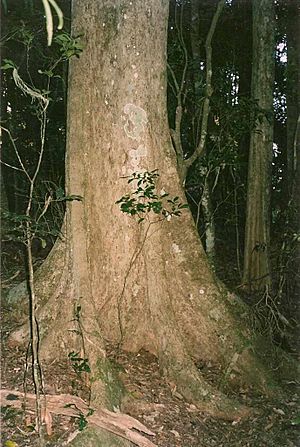Purple cherry facts for kids
Quick facts for kids Purple cherry |
|
|---|---|
 |
|
| Large Syzygium crebrinerve - Lamington National Park, Australia. | |
| Scientific classification | |
| Genus: |
Syzygium
|
| Species: |
crebrinerve
|
| Synonyms | |
|
Eugenia crebrinervis C. White |
|
Syzygium crebrinerve is a tree found in Australia. It grows from Taree, New South Wales in the south to Calliope, Queensland in the north. People often call it the purple cherry, rose satinash, or black water gum. This tree likes to grow in warm, wet rainforests. It prefers rich soils that come from volcanic rock or river deposits.
Contents
What the Purple Cherry Tree Looks Like
The Syzygium crebrinerve is a medium to tall tree. It can sometimes grow as high as 45 metres (about 148 feet). Its trunk can be up to one metre (about 3 feet) wide. The top of the tree looks dark and full. However, its new leaves are a bright red colour.
The bark of the tree is grey or fawn. It has many small dents where pieces of bark have fallen off. The new bark underneath is a purplish-brown colour. Big Syzygium crebrinerve trees often have large buttress roots at their base. These roots help to support the tall tree.
Leaves, Flowers, and Fruit
The leaves grow in pairs on opposite sides of the branch. They are simple and smooth, growing up to 11 centimetres (about 4 inches) long. The ends of the leaves are narrow and come to a point. Young leaves are a bright red, which makes them easy to spot. If you look closely, you can see small oil dots on the leaves. The leaf stalks are about 6 millimetres (less than an inch) long.
The flowers are white and grow in clusters called panicles at the ends of the branches. They usually appear in November and December.
The fruit of the Syzygium crebrinerve ripens from January to April. It is a flat, round berry, which is common for many Syzygium trees. The fruit can be pink or purple. Humans usually do not like to eat this fruit because it is dry and does not have much taste. However, many rainforest birds, like the topknot pigeon, enjoy eating it.
Growing New Trees
Growing Syzygium crebrinerve from seeds can be tricky. The seeds often sprout slowly and at different times. Sometimes, insects lay their eggs in the fruit. Soaking the seeds in water can help to get rid of these insect larvae. When people try to grow these seeds, anywhere from 27% to 100% of them might sprout.
See also
 In Spanish: Syzygium crebrinerve para niños
In Spanish: Syzygium crebrinerve para niños



